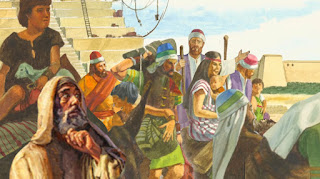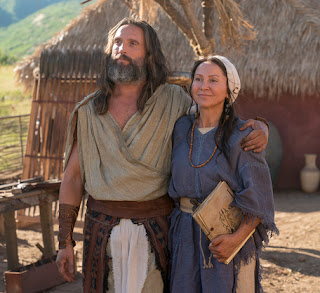For instance, consider an article “Searching for Book of Mormon Ruins—What should we expect to find?” by Lynn and David Rosenthall, September 2010, who make an extreme effort to point out that stone was not used to build either the Nephie temples in the Land of Promise nor the Jewish temples in what is now Israel. On one occasion, they write: “We have scoured the scriptures trying to validate any of the claims that the people in the Book of Mormon record built large stone structures. We have found from the text of the Book of Mormon that the people, not unlike the children of Israel in the Biblical record, built with wood, metals and sometimes cement materials.”
Book of Mormon record keepers
To answer the latter, let us consider Mormon’s comment: “and also building walls of stone to encircle them about, round about their cities and the borders of their lands; yea, all round about the land” (Alma 48:8), which sounds like a lot more than “breastwork of timbers” or “ridges of earth.” However, let us take a look at one more area where Noah “also built him a spacious palace, and a throne in the midst thereof, all of which was of fine wood and was ornamented with gold and silver and with precious things” (Mosiah 11:9), which suggests some monumental building.
However, the most important part is when the Rosenthals write: “In all the recorded descriptions of Nephite temples, built in four widely scattered areas of the Nephite lands, there is not a single mention of stone construction. The record does indicate, however, that their temples were built of wood (timber) and metal of various types. And Mormon indicates that the Nephite structures “were built after the manner of the Jews” (Alma 16:13). No temple is described as pyramidal in shape nor monumental in purpose or built to honor a leader or its builder. According to the Book of Mormon record, these temples were built for ordinance observance and worship as revealed by the Lord, not unlike the tabernacle of Moses, the temple of Solomon or the temple in Kirtland, Ohio, and subsequent temples in this dispensation (D&C 94:1–9; 105:33; 109:2–4).”
Now, the most important thing mentioned in the above statement, which was listed almost as an afterthought, is that which Mormon informs us. The Rosenthals wrote: “And Mormon indicates that the Nephite structures “were built after the manner of the Jews” (Alma 16:13, emphasis added).”
The Jews built the temple out of stone, covered the inside with cedar
paneling, and covered that with gold sheets. Wood was used for structural
purpose for floors, second story and roof
“The stone of which the Temple was built was dressed at the quarry, so that no work of that kind was necessary within the Temple precincts (I Kings vi. 7). The roof was of cedar, and the whole house was overlaid with gold (I Kings vi. 9, 22).”
Now the Resenthals make a point of showing that: “Solomon’s temple was built primarily of wood (cedar, cypress, juniper, olive and pine) and metal (gold and bronze) and precious gemstones.”
However, this again is not only inaccurate, but the use of wood in the temple’s construction is totally misleading, other than for bracing, such as floors and ceilings. As an example, “Solomon’s temple wall was not of equal thickness all the way up, but had ledges on which the floor-beams rested” (Encyclopedia), showing, that the walls of stone had niches or ledges upon which wood beams rested for their support, upon which floors of wood were laid.
As for the cedar, “the Holy of Holies interior was lined with cedar and overlaid with pure gold.” Obviously, the stone of which the temple was built was not decorative, but the basis of the structure and what gave the three story building its needed support. In the Holy of Holies, the most important room or chamber in the entire temple, the stone walls were “lined with cedar panels,” which in turn, were “overlaid with pure gold.”
The two cherubim in the Holy of Holies
Now, the rest of the temple building, which was also built of stone, the walls “were lined with cedar, on which were carved figures of cherubim, palm-trees, and open flowers, which were overlaid with gold” (Encyclopedia). Also, “the floor of the Temple was of fir-wood overlaid with gold. The door-posts, of olive-wood, supported folding-doors of fir. The doors of the Holy of Holies were of olive-wood. On both sets of doors were carved cherubim, palm-trees, and flowers, all being overlaid with gold (I Kings vi. 15 et seq.)” (Encyclopedia).
It should also be kept in mind that the temple was built on the dome of a rock, not a place or foundation for a wood building, but one using a stone base and stone walls. Neither were the altars built of wood, but of bronze and unhewn stone (Encyclopedia). Also, since the walls are stated to be “of equal thickness,” this would relate to a stone cut to size, rather than timbers which come that way.
The Rosenthals go on to write: “We need not look, therefore, to areas of ostentatious and extensive ruins in the Western Hemisphere to find the heartlands of the Book of Mormon peoples, that is, the actual locations where the record keepers lived and wrote the geographical descriptions of their land.”
Solomon’s great wealth—Nephi built his temple like that of Solomon
Part of the problem is jumping to conclusions, such as Rosenthals’ statement: “Not unlike the palace and other buildings that king Noah previously built of wood, along with “precious things, of gold, and of silver, and of iron, and of brass, and of ziff, and of copper,” it is not unexpected that the temple renovations were also built of wood and these same listed materials” (Mosiah 11:8–9).
While there is no way to know what materials were used, it should be obviously apparent that in 600 BC, massive buildings could not be built with wood and decorative metals alone—lsuch large buu8ildings were built of stone, with wood used for supports, such as flooring and ceiling and decorative uses.
In addition, the Rosenthals state: “Clearly “fine wood,” and “copper” and “brass” were the principal building materials in the restoration of this first Nephite temple, with an emphasis on “fine wood” construction.”
Again, this is patently not true. Not only can you not build large structures out of only wood, copper and brass, but that these are all “decorative materials,” which is seen in the Jews nature of building their temples of stone, and decorating them with wood, gold, etc.
Another inaccurate statement is: “But as with temples today, the most important “manner” of construction might not have been the size, shape nor the materials, but the intent of building a well-crafted and attractive temple, though small, as a place for the performance of sacred ordinances, including, for the Nephites, the ordinances and practices of the law of Moses.”
LDS temples today are magnificent examples of exterior beauty and
internal function
What is important is to be honest in writing about the Book of Mormon, specifically regarding the geographical settings and the many descriptions provided. When personal opinion drives the dialogue, nothing at all is accomplished. As Mormon tells us, the Nephites built after the manner of the Jews, and the Jews built with stone, therefore to claim that the Nephites only built with wood is simply not true, and totally misleading,
The Rosenthals, of course, have their mind set on Baja California being the Land of Promise, which has no ruins to speak of and therefore, they must find a way to diminish and disqualify both Mesoamerica and Andean Peru because of the stone ruins found in those two place. Therefore, we have their very long explanation as to why there should be no stone buildings found in the Land of Promise, which is contrary to what they themselves quote in their own article as pointed out above.






























